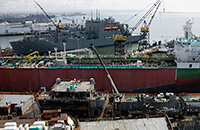General Dynamics NASSCO
National Steel and Shipbuilding Company (NASSCO) is one of three shipyards in the Marine Systems division of General Dynamics Corporation. Located on San Diego Bay, California, NASSCO employs approximately 3,600 workers and is the only major shipbuilding yard on the West Coast.

Written by Aaron Munz • Edited By Walter Pacheco
Asbestos.com is the nation’s most trusted mesothelioma resource
The Mesothelioma Center at Asbestos.com has provided patients and their loved ones the most updated and reliable information on mesothelioma and asbestos exposure since 2006.
Our team of Patient Advocates includes a medical doctor, a registered nurse, health services administrators, veterans, VA-accredited Claims Agents, an oncology patient navigator and hospice care expert. Their combined expertise means we help any mesothelioma patient or loved one through every step of their cancer journey.
More than 30 contributors, including mesothelioma doctors, survivors, health care professionals and other experts, have peer-reviewed our website and written unique research-driven articles to ensure you get the highest-quality medical and health information.
About The Mesothelioma Center at Asbestos.com
- Assisting mesothelioma patients and their loved ones since 2006.
- Helps more than 50% of mesothelioma patients diagnosed annually in the U.S.
- A+ rating from the Better Business Bureau.
- 5-star reviewed mesothelioma and support organization.
Testimonials
My family has only the highest compliment for the assistance and support that we received from The Mesothelioma Center. This is a staff of compassionate and knowledgeable individuals who respect what your family is experiencing and who go the extra mile to make an unfortunate diagnosis less stressful. Information and assistance were provided by The Mesothelioma Center at no cost to our family.LashawnMesothelioma patient’s daughter
How to Cite Asbestos.com’s Article
APA
Munz, A. (2023, August 30). General Dynamics NASSCO. Asbestos.com. Retrieved April 20, 2024, from https://www.asbestos.com/shipyards/nassco/
MLA
Munz, Aaron. "General Dynamics NASSCO." Asbestos.com, 30 Aug 2023, https://www.asbestos.com/shipyards/nassco/.
Chicago
Munz, Aaron. "General Dynamics NASSCO." Asbestos.com. Last modified August 30, 2023. https://www.asbestos.com/shipyards/nassco/.
NASSCO’s history, like other places that build ships in the U.S., had a problem with asbestos. Until the 1970s, ships were constructed and fixed using asbestos parts and products. This material was in insulation, boilers, pipes, ceiling tiles and floors.
Asbestos could handle high heat and prevent fires. Sometimes, they removed asbestos and put it back in when the ships were under repair.
Shipyard employees were not the only workers who handled these products. Other companies that helped with the building also used asbestos. This caused asbestos to get into the air and make the workplace dangerous.
The International Journal of Environmental Health Research published a study in 2021. It found that sailors from five Nordic countries are more than twice as likely to get mesothelioma compared to regular people.
NASSCO Occupational Asbestos Exposure
NASSCO had to defend itself in court over asbestos. A couple claimed that the shipyard made them sick. Aida Savelesky said that her husband Allen worked with asbestos at NASSCO. She got exposed through him, which made her develop mesothelioma.
Aida Savelesky took the shipyard to court and made two arguments. First, she said her husband got close to asbestos while working at NASSCO. This type of exposure is called occupational exposure. The asbestos stuck to his skin, hair, clothes and shoes. This exposed her to asbestos.
In her second argument, Mrs. Savelesky claimed that NASSCO was careless in choosing to use asbestos. She said that because of the shipyard’s actions, she breathed in the asbestos fibers, which caused her to get sick.
In July 2011, the U.S. District Court decided to send the case back to a different court for more review. The outcome is unknown.

NASSCO Employees and NASSCO Lawsuits
In a 2006 case, NASSCO was accused by the Shipyard Workers Union of violating Section 8(a) (1) and (5) of the collective bargaining agreement when the Company refused to allow the union to remove a previously appointed health and safety representative and replace them with a union health and safety representative.
In the 1980s, the yard and the seven unions affiliated with the Shipbuilders Union agreed to the creation of a company paid union health and safety representative. This union representative performed the same duties as the non-union safety representative and worked under the supervision of safety manager just as they did. The one important difference was that the union representative remained a part of the bargaining unit. The company was ordered to allow the unions to select their own representative.
In another case brought by the Shipyard Workers Union the previous year, NASSCO was charged with violating meal and break time laws. The union had documented over 1,000 separation violation claims placed with the California Division of Labor Standards Enforcement over a four year period.
In addition to rectifying these violations, the union was trying improve the safety record at NASSCO. An organizer for the Boilermakers Union was quoted in an article as saying that “NASSCO had the worst safety record of any shipyard in the country.”
NASSCO and OSHA Violations
From the 1970s to the year 2000, the Occupational Safety and Health Administration (OSHA) cited NASSCO. They found problems that NASSCO knew about but refused to fix.
There were hundreds of issues, including asbestos. The yard was aware of the asbestos contamination. NASSCO didn’t get rid of it when they were supposed to, as OSHA found out later.







